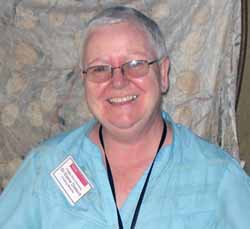It is a matter of urgency that the impact of maternity unit closures on Australian women living in rural and remote areas is addressed, according to Charles Sturt University (CSU) midwifery academic Dr Elaine Dietsch.
The comments come with the release of the document, Improving Maternity Services in Australia: A Discussion Paper from the Australian Government.
 “Maternity unit closures have placed women living in rural and remote areas at incredible disadvantage and unnecessarily higher risk,” said Dr Dietsch, who is the midwifery course coordinator at CSU.
“Maternity unit closures have placed women living in rural and remote areas at incredible disadvantage and unnecessarily higher risk,” said Dr Dietsch, who is the midwifery course coordinator at CSU.The discussion paper notes that while women from outer regional areas nationally account for 10 per cent of births, the maternal death rate for these women is 16 per cent of the total maternal mortality rate. Women in remote areas account for 3 per cent of the births but 7 per cent of the total maternal deaths.
“Australia could learn from Canada and New Zealand which have been effective in their endeavours to improve outcomes for women and their babies who reside in rural and remote areas,” said the CSU academic.
“While New Zealand is much smaller geographically than Australia, terrain can increase the isolation of women.
“In Canada, healthy Inuit women from very remote areas, who would sometimes have to fly up to five hours between a remote town and the nearest referral maternity unit, are able to give to birth in their own communities with qualified midwives from their own villages.
“It is neither acceptable nor affordable for healthy women, their families or communities to have no choice but to be forcefully evacuated from their own rural communities to give birth. Nor is there any evidence to demonstrate that it improves health outcomes,” said Dr Dietsch.
“The discussion paper encourages us to consider strategies such as midwifery-led continuity of care for pregnant, birthing and postnatal women to improve the experience and health outcomes for healthy women. I endorse this strategy, especially for healthy women living in rural areas,” she said.
“This is not a new model of care, rather one that has already been successfully adopted internationally and in some areas of Australia. However, strategies need to be developed and models of care such as this one expanded with government support.
“The World Health Organization has identified midwives as the optimum health professional to support healthy women during pregnancy, labour, birth and the postnatal periods.”
The midwifery team at CSU already proactively addresses some of the issues identified in the discussion paper:
- A research project now being finalised has focussed on women living in rural and remote areas and their experiences of being forced to move away from their communities to give birth as more rural maternity services close or limit their services. As part of the project, which was funded by the Nurses and Midwives Board of NSW, women also shared their hopes for the future of rural maternity services.
- To address the midwifery workforce issues especially in rural areas, numbers enrolled in the CSU postgraduate Diploma of Midwifery has expanded exponentially. In 1990, four students were enrolled in this distance education program from one area health service. In 2008, 63 students are enrolled from over 50 maternity units in six states and territories. The flexible program enables registered nurses who would like to become midwives to live, work and study in their home communities.
- Drawing on the success of the postgraduate Diploma of Midwifery, CSU is developing a Bachelor of Midwifery, which will also enable students to live, work and study in their home communities. Learning lessons from Canada and New Zealand, the CSU program will focus on recruiting students who are Indigenous health workers or have a special interest in providing woman-centred midwifery care in their local areas such as lactation consultants and enrolled nurses experienced in providing care to women in maternity units.
“This is a much needed and timely discussion paper and I encourage all stakeholders including women, midwives and our medical colleagues to comment on the document,” said Dr Dietsch.
The discussion paper released on Wednesday 10 September is a part of a review of maternity services in Australia being led by the Chief Nurse and Midwifery Officer, Ms Rosemary Bryant.





Social
Explore the world of social